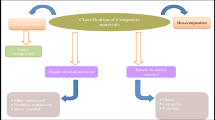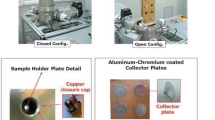Abstract
The intense research and development efforts in space industries leads to the design and manufacturing of carbon fiber reinforced polymer (CFRP) applications for high specific stiffness structural components. Nowadays, there is much research on replacing the traditional space qualified high-density materials. CFRP has low thermal and electrical conductivity due to the non-conductive nature of the polymer, which limits its utilization in space industries. These are essential properties for space component design. Advanced nanomaterial, multi-walled carbon nanotubes (MWCNTs) with 0.4 wt.% reinforcement in epoxy enhances the thermal and electrical conductivities by 41% and 500–625%, respectively, which is sufficient to electroplate the CFRP. Direct electroplating without surface activation on MWCNTs composite can be achieved due to enhancement of the electrical conductivity, which is not feasible in the case of neat CFRP. However, homogeneous dispersion of CNT is essential for better electroplating adhesion strength. Electroplating on CFRP components results allow us to explore the potential applications for future geo-space missions such as carrier plates and radio frequency (RF) filters. The paper explains the fabrication of the tailored CNT-CFRP composite sample and characterization that includes the properties such as thermal expansion, thermal conductivity and electrical resistance, which is a significant preceding step for any material to be space-qualified.







Similar content being viewed by others
References
B.N. Agrawal, Design of Geosynchronous spacecraft (Englewood Cliffs, N.J.: Prentice-Hall, 1986).
R. Prabhakaran, J Aerosp Sci Technol 67, 1 (2015).
M. Martins, R. Gomes, L. Pina, C. Pereira, O. Reichmann, D. Teti, N. Correia, and N. Rocha, Highly conductive carbon fiber-reinforced polymer composite electronic box: out-of-autoclave manufacturing for space applications Fiber 6, 92 (2018).
M. Pecht, Handbook of electronics package design (New York: Marcel Dekker Inc., 1991).
D.A. Vartak, and V.K. Manglik, IJERT 3(3), 1572 (2014).
A.Y. Boroujeni, and M. Al-Haik, Compos Part B Eng 164, 537 (2019).
D.A. Vartak, Failure analysis of MIC substrate for satellite communication payloads and possible solutions National Conference Indus University, Ahmedabad (2014).
J.F. Guedes, M.S. Martins, R. Martins, and N. Rocha, Adv Polym Technol, Article ID 6520972 (2019).
P.S. Rao, S. Anandatheertha, G.N. Naik, and S. Gopalakrishnan, Sadhana Indian Acad. Sci. 40, 1301 (2015).
T. Jadam, S.K. Sahu, S. Datta, and M. Masanta, Sadhana Indian Acad. Sci. 45, 135 (2020). https://doi.org/10.1007/s12046-020-01378-2.
N. Wu, J Aeronaut Aerosp Eng 1(4), 119 (2012).
S.U. Khan, and J.K. Kim, Int J Aeronaut Space Sci 12, 115 (2011).
I. Gouzman, E. Grossman, R. Verker, N. Atar, A. Bolker, and N. Eliaz, Adv Mater Space Worthy Mater Progress Rep (2019). https://doi.org/10.1002/adma.201807738.
D.B. Kumar, and G. Popli, Int. J. Res. Appl. Sci. Eng. Technol. 3(7), 558 (2015).
T.K. Das, and S. Prusty, Polym. Plast. Technol. Eng. 52, 319 (2013).
K. Singh, H.R. Kansara, V. Venkatesh, A.V. Nirmal, and S.V. Sharma, in 2nd IEEE International Conference on Power Electronics, Intelligent Control and Energy Systems (ICPEICES), Delhi, India (2018). https://doi.org/10.1109/ICPEICES.2018.8897446.
F. Du, C. Guthy, T. Kashiwagi, J.E. Fischer, and K.I. Winey, J Polym Sci Part B Polym Phys 44, 1513 (2006). https://doi.org/10.1002/polb.20801.
ASTM E 228, Standard Test Method for Linear Thermal Expansion of Solid Materials with a Push Rod Dilatometer, American Society for Testing and Materials (2017).
ASTM E 1269, Standard Test Method for Determining Specific Heat Capacity by Differential Scanning Calorimetry. American Society for Testing and Materials (2018).
ASTM E 1461, Standard Test Method for Thermal Diffusivity by the Flash Method. American Society for Testing and Materials (2011).
ASTM D 4762 - 18, Standard Guide for Testing Polymer Matrix Composite Materials. American Society for Testing and Materials (2018).
F. Tariq, M. Shifa, and R.A. Baloch, Arab J Sci Eng 43, 5937 (2018).
N.R. Pradhan, H. Duan, J. Liang, and G.S. Iannacchione, Nanotechnology 20, 245705 (2009).
T.R. Pozegic et al., Sci Rep 6, 1 (2016).
J.-W. Lee, S.-J. Park, and Y.-H. Kim, Res. Phys. 9, 1 (2018).
A. Lonjon, P. Demont, E. Dantras, and C. Lacabanne, J Non-Crystalline Solids 358, 1859 (2012).
S. Lee, K. Ko, J. Youk, D. Lim, and W. Jeong, Polymers (Basel) 11, 1597 (2019). https://doi.org/10.3390/polym11101597.
Y. Li, and M. Ma, Study on the Electrical Properties of CNT/Carbon Fiber Reinforced Composite in Materials Science Forum (Stafa: Trans Tech Publication, 2015).
F. Zhou, J. Zhang, S. Song, D. Yang, and C. Wang, Materials 12, 1025 (2019). https://doi.org/10.3390/ma12071025.
R. Kulkarni, and O. Ochoa, J Compos Mater 40, 733 (2006).
Rawal S, Brantley J, Karabudak N, RAST 2013—Proceedings of 6th International conference on Recent Advances in Space Technologies, pp. 13-19. (2013). https://doi.org/10.1109/RAST.2013.6581186.
NASA exploring using carbon nanotube for aerospace application. Composites Worlds (2017).
D.A. Vartak, B. Satyanarayana, B.S. Munjal, K.B. Vyas, P. Bhatt, and A.K. Lal, Aust J Mech Eng (2020). https://doi.org/10.1080/14484846.2020.1733176.
J.A. Samareh, and E.J. Siochi, Nanotechnology 28, 372001 (2017). https://doi.org/10.1088/1361-6528/aa7c5a.
Acknowledgment
We are thankful to Shri. K. B. Vyas, Group Director, MQAG, Shri. Milind Mahajan, Group Director-ASG for guidance and valuable suggestions. Shri. Sharad Shukla, Head-STPD, Smt. Nandini Deshpande Engr.-TED, Smt. Meghal Desai Engr.-QACD, Shri. Anant Suvarnakar Techncn-PMF, of Space Applications Centre-ISRO and Dr. Kartikeyan S. (Director, Institute for Environmental nanotechnology) for technical support. We would also like to offer our gratitude to Shri. N. M. Desai, Associate Director, and Shri. D. K. Das, Director, Space Applications Centre (ISRO) Ahmedabad for their kind support and constant encouragement.
Author information
Authors and Affiliations
Corresponding author
Ethics declarations
Conflict of interest
The authors declare that they have no conflict of interest.
Additional information
Publisher's Note
Springer Nature remains neutral with regard to jurisdictional claims in published maps and institutional affiliations.
Rights and permissions
About this article
Cite this article
Vartak, D., Ghotekar, Y., Munjal, B.S. et al. Characterization of Tailored Multi-walled Carbon Nanotubes Based Composite for Geo-Space Payload Components. Journal of Elec Materi 50, 4442–4449 (2021). https://doi.org/10.1007/s11664-021-08978-6
Received:
Accepted:
Published:
Issue Date:
DOI: https://doi.org/10.1007/s11664-021-08978-6




